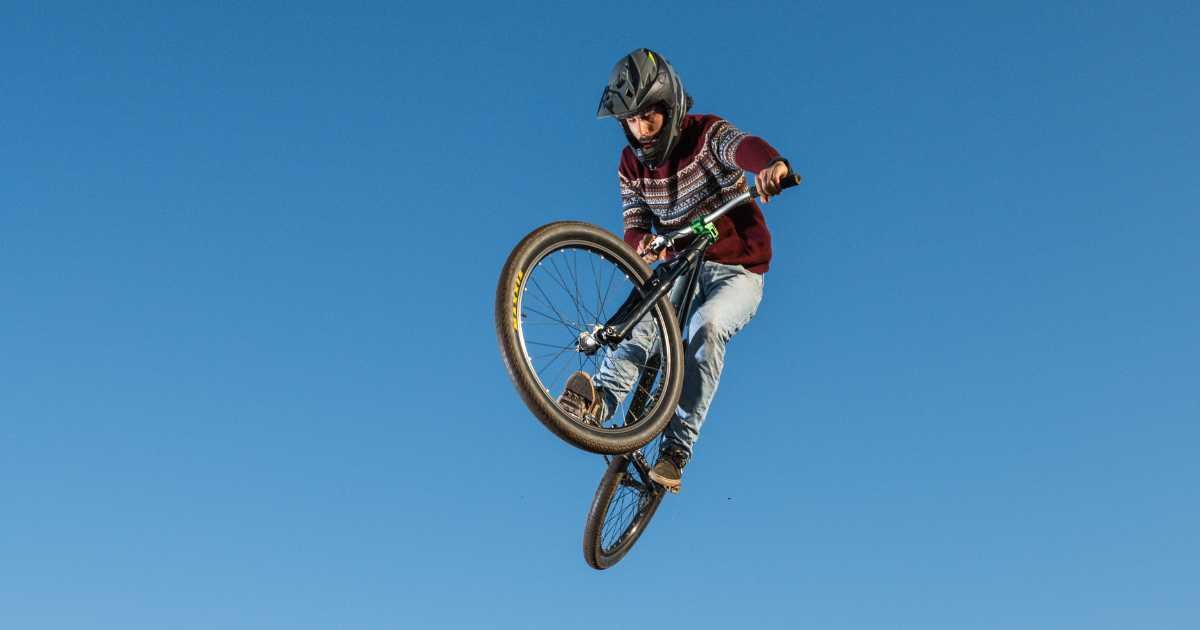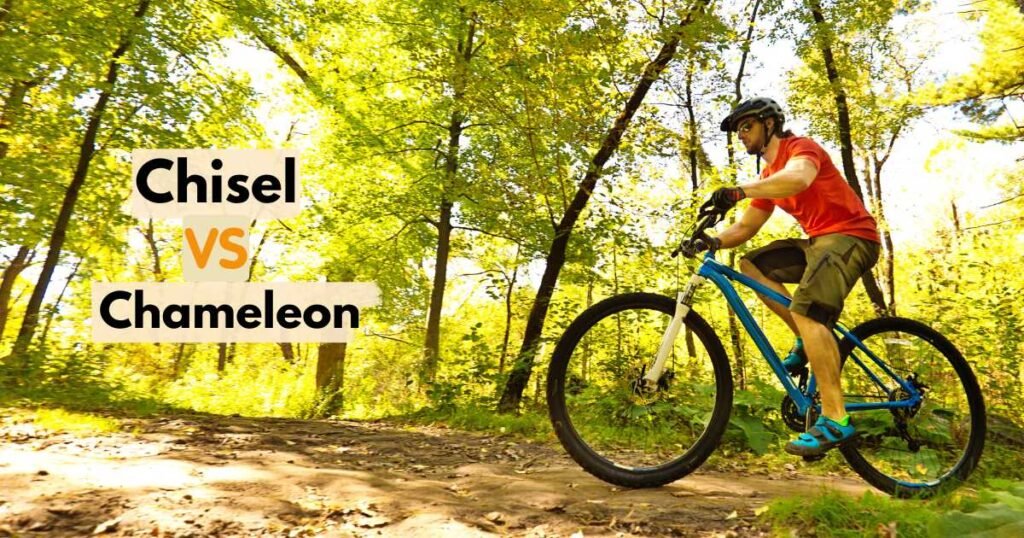Chisel vs Chameleon? If you’re stuck between the Specialized Chisel and the Santa Cruz Chameleon, I can understand it.
They both look premium, both claim performance, both have solid fan bases — but in reality, these two hardtails live in two very different worlds.
The problem is, at first glance, they kinda trick you because both come in aluminum, both look clean, and both perform well.
But when you really dig into how they ride, what they’re made for, and what kind of rider actually needs them, things become super clear.
And trust me, by the time you reach the end, you’ll know exactly which bike deserves your money — and why.
Specialized Chisel — What It Actually Is

Let’s start here because the Chisel often gets misunderstood.
People think it’s just another mid-level XC bike. Nope.
This thing is an XC race-bred hardtail, designed to give you almost carbon-like performance at an alloy price.
Specialized uses its Smartweld M5 aluminum, which literally shifts weld points away from high-stress zones.
That’s how they make it so damn light yet stiff where it matters.
Weight-wise, the Chisel sits around 10.8 to 11.5kg, depending on trim.
The frame itself is roughly 1.3–1.4kg, which is insane for alloy.
Geometry-wise, it’s got a 68° head tube angle and 74° seat tube, which gives it a perfect balance between climbing precision and stable descending.
If you’ve read my Chisel Hardtail vs Full Suspension, you’ll already know — the Chisel sits right at the sweet spot. Not too twitchy like old XC bikes, not too lazy like heavy trail rigs.
It’s purpose-built for speed, marathon rides, and all-day efficiency.
Santa Cruz Chameleon — What It Really Represents
Now let’s switch lanes. The Santa Cruz Chameleon is not trying to race. It’s trying to do everything else.
It’s the one bike you pick when you don’t want limits.
You can run it geared or single-speed, 27.5+ or 29-inch wheels, even a mullet setup.
That’s where the name “Chameleon” fits — it adapts to whatever you throw at it.
The alloy version weighs around 12.8 to 13.5kg, and yeah, that’s heavier.
But the frame is built like a tank — thick 6000-series aluminum, rock-solid welds, and Santa Cruz’s lifetime warranty.
Geometry’s slacker at 65° head angle, slightly steeper seat tube at 74.7°, which means more control downhill and better balance on steeper technical lines.
Where the Chisel feels like a scalpel, the Chameleon feels like a sledgehammer that still dances.
You can absolutely smash rocky trails on it, then ride back home without feeling like you’re carrying a downhill bike.
Frame Quality & Real Ride Feel

Both use aluminum, but the type and intention are totally different.
The Chisel’s M5 Smartweld frame is engineered around precision. The welds are literally offset to reduce stress points and weight.
You get that feeling of “instant feedback” the moment you push the pedal.
The bike surges forward, almost like it reads your next move. You’ll feel it most on tight climbs — it just sprints up.
Now, the Chameleon’s alloy frame is thick, solid, and confidence-boosting.
The feel isn’t “light and zippy” — it’s stable and fun.
The slacker geometry keeps you planted on descents.
When you ride it, you can jump off roots, hit berms, or even load it up for a mini bikepacking trip. It can take it all.
You can’t say that about the Chisel — it’s light and efficient but doesn’t like abuse.
Ride it on flowy XC trails or endurance loops, not constant rock gardens.
I’d actually say:
- Chisel is what you pick when you want speed.
- Chameleon is what you pick when you want freedom.
Drivetrain & Components

The Chisel usually comes with SRAM NX Eagle or Shimano Deore 12-speed, depending on the build.
Fork options range from RockShox Judy on the base to Reba or SID on higher trims. It’s a 100mm travel XC setup.
Wheels? 29” only, with 2.35” Fast Trak tires or similar. Brakes are typically SRAM Level or Tektro hydraulic.
All that screams one thing — lightweight efficiency. It’s simple, clean, and optimized for performance.
Now, Chameleon takes a different route.
Builds vary a ton, but the stock ones usually have RockShox Pike 130mm or Fox 34 120mm, SRAM GX/NX Eagle, and G2 or Guide T brakes.
It rolls on 2.4–2.6” tires. The components are overbuilt, trail-ready, and designed to take hits.
You can actually convert the Chameleon into a single-speed setup using its adjustable dropouts — that’s something the Chisel can never do.
And if you’re into customizing, the Chameleon wins easily.
If you’re wondering about upgrade potential — check out Best Upgrades for Specialized Chisel, I’ve listed everything from cockpit to wheels that actually make sense for it.
Price & Value Breakdown
Price always plays a part. The Chisel Alloy builds start at around $1,800 USD, going up to $2,400+ for Comp and Expert versions.
The Santa Cruz Chameleon Alloy starts near $2,000, but easily crosses $2,700–$3,000 depending on the kit.
There’s also a Carbon Chameleon version, and just the frame costs around $999, full builds around $3,200–$3,600.
Now here’s the thing:
For that extra few hundred bucks, Chameleon gives you trail ruggedness and custom freedom.
But the Chisel gives you speed per dollar unmatched in its class.
It’s the most refined XC aluminum hardtail right now under $2,500.
If you have seen Specialized Chisel vs Epic Hardtail, you know even the Epic Hardtail struggles to justify its extra cost if you’re not racing full-time.
So, in pure price-to-performance:
- For XC → Chisel wins.
- For all-round, fun trail life → Chameleon wins.
Durability & Long-Term Ownership

Durability is one area where Santa Cruz simply outplays.
The Chameleon can take years of beating, and it’s backed by a lifetime warranty. You’ll scratch it, drop it, crash it — it’ll still go on.
Santa Cruz paint quality is top-tier, too. It barely chips even when you ride aggressive trails every weekend.
The Chisel, being lighter, is naturally thinner in tubing. The Smartweld design keeps it strong enough for XC abuse, but it’s not made for repeated jumps or crashes.
It can easily handle marathons, rocky climbs, or light descents, but if you plan to ride bike parks or hard jumps, you’ll feel its limit.
Still, for its purpose, it’s incredibly well-built.
Specialized alloy frames last long if treated for what they’re built for.
If you want something, you’ll rebuild every few seasons with different forks, maybe even run single-speed for fun — Chameleon fits that idea better.
Ride Experience — How They Actually Feel on Trail

You can’t really compare these two just by geometry charts.
The Chisel, when you get on it, immediately feels “alive.” You push the pedal — instant acceleration. You climb — feels like cheating.
The rear triangle is stiff but doesn’t beat you up. Downhill, it’s not scary either, though you have to pick your lines carefully.
The Chameleon, the moment you drop in, feels like a playground.
The slacker front lets you point-and-roll over rocks, it manuals easily, and you can corner aggressively without fear of washing out.
It’s not about pedaling speed — it’s about fun, control, and personality.
If you’ve ever ridden both back-to-back, you’ll notice:
- Chisel is silent, fast, and composed.
- Chameleon is loud, reactive, and raw.
Different energy.
And the thing is, the Chisel teaches discipline. It rewards smooth pedaling, clean lines, and endurance.
The Chameleon invites chaos. It rewards creative riding and confidence. You can’t go wrong with either — just depends on your style.
Maintenance, Parts & Upgrades
The chisel is low maintenance.
One drivetrain, 100mm fork, simple design — just keep the chain clean, check torque bolts, and it’ll run for seasons.
Upgrades that make sense: lighter wheelset, carbon bar, and a better fork if you want it to feel near race-level (see the Chisel Upgrades guide linked above).
Chameleon needs more attention. The longer fork, dropouts, and bigger tires — you’ll be checking alignment more often.
It’s not bad, just part of the deal when you ride harder.
On the flip side, it’s much easier to experiment with. You can slap a new fork, different wheels, mullet, whatever. It’ll accept it.
If you plan to own just one bike long term, Chameleon gives you more paths to explore.
But if you plan to keep bikes separately for different purposes — Chisel will shine as your dedicated XC machine.
Looks, Finish & Feel
Visually, both kill it in their own way. The Chisel has a subtle, clean, fast vibe.
The matte paint, internal routing, minimal branding — it’s classy, racey, understated.
The Chameleon is more expressive — colors like Gloss Yellow, Navy, Matte Olive.
It just screams “fun.” The welds are clean too, but chunkier — you can tell it’s built tough.
In hand, the Chisel feels light and delicate, like something that belongs in a race lineup.
The Chameleon feels like it’s begging to be thrown around. It’s personal preference — do you want a precision tool, or a play weapon?
Conclusion — So, Which One Should You Go With?
It comes down to one straight thing — what kind of rider you are, and what you want your bike to do for you.
If you’re someone who loves covering distance fast, enjoys the rhythm of pedaling, the challenge of climbs, and wants a bike that gives every ounce of power back into motion — the Specialized Chisel is made for you.
It’s not just lightweight; it’s pure efficiency on two wheels. You’ll get more out of every pedal stroke, and it still stays comfortable for long XC rides.
But if you want a bike that’s tougher, can take a beating, and keeps you smiling even when the trail gets rough, then the Santa Cruz Chameleon is the better choice.
It’s more playful, more durable, and gives you that “do whatever, go wherever” confidence.
You can set it up mullet, single-speed, trail, or even for light bikepacking — it’s that flexible.
To put it short:
- Choose Chisel: if your rides are about speed, precision, fitness, XC loops, or races.
- Choose Chameleon: if your rides are about fun, control, hitting trails, and long-term durability.
Both are premium hardtails with purpose. So, you have to decide if you want a sharp race blade or a trail hammer.
FAQs
Can I use the Chisel for trail riding too, or will it break?
You can ride it on smoother trails, yes — the frame is strong enough for XC-level abuse.
But it’s not built for continuous drops or heavy jump lines.
Occasional rocky sections are fine, but if your trails involve constant pounding, you’ll feel the limits. That’s where the Chameleon wins with its slacker geometry and sturdier frame.
Is the Santa Cruz Chameleon worth the higher price?
Yes, if you value long-term versatility. It’s not just about the frame — it’s about freedom.
You can rebuild it multiple ways over the years, and the lifetime warranty alone makes it a worthy investment.
You pay more upfront, but you get a bike that evolves with you, not one you outgrow in a season.
Which one climbs better — Chisel or Chameleon?
No contest — Chisel. It’s lighter, stiffer, and optimized for efficiency. The 68° head angle and low frame weight make steep climbs smoother.
The Chameleon climbs decently for a trail bike, but it’s more about control and fun on the way down, not raw uphill speed.
I want a bike that lasts 5–7 years. Which one will survive longer?
Both can last that long if maintained well, but Chameleon will hold up better physically — thicker tubing, stronger welds, and designed for harsher trails.
The Chisel, however, will age gracefully if used for what it’s meant for — XC, fitness, and endurance.
So, durability is about how you ride, not just how long you ride.

Ali is the founder of Mountain Bike Insider and an passionate rider with years of hands-on experience in mountain biking. From testing gear to exploring trails, Ali writes based on real riding knowledge to help others make smart, safe, and enjoyable biking choices. Every guide is built on research, personal use, and a passion for the sport.







